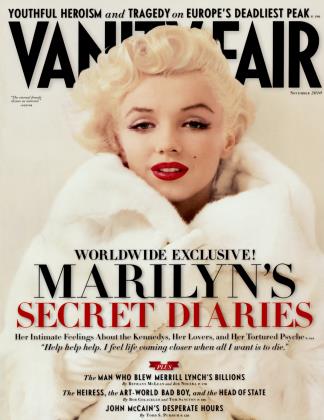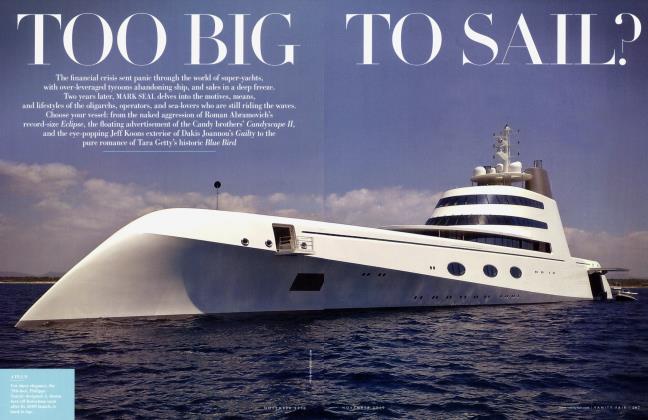Sign In to Your Account
Subscribers have complete access to the archive.
Sign In Not a Subscriber?Join NowTHE STORK CLUB
Founded as a speakeasy in the 1920s, the Stork became the first and last word in elite supper-clubbing. Everyone went there: Jack and Jackie. Marilyn and Joe. the Duke and Duchess of Windsor. Hemingway, and Hitchcock. Each little table sported a discreet telephone, on which you could dial the other tables: That is a charming feature.
UMBRELLAS
Beautiful ones with carved handles, instead of those silly guaranteed-to-break-immediately quasi-disposable ones that you always see jutting out of street-corner garbage cans.
FEMMES FATALES
Hollywood used to be absolutely heaving with femmes fatales: Louise Brooks, Rita Hayworth, Joan Bennett, and Veronica Lake, to name but a few; the great Marlene Dietrich alone was—cinematically speaking—responsible for the downfall of a veritable army of men.
RADIO DRAMAS
A picture may be worth a thousand words, but radio plays let the imagination run wild.
HUMPHREY BOGART (1899-1957)
Bogart played characters who balanced machismo with tenderness and inner nobility—a formula so attractive that someone should figure out how to bottle it.
HEADSCARVES
Very Jackie-Kennedy-and-Lee-Radziwill-in-Capri, they’re an excellent alternative to pulling your hair back into a drab ponytail. Headscarves are also good when zipping around in a convertible.
GEORGE S. KAUFMAN (1889-1961)
One of the most brilliantly acerbic playwrights of the 20th century, Kaufman was perhaps most renowned for creating the charismatic (and preposterously awful) “Sheridan Whiteside," the main character of The Man Who Came to Dinner (who was modeled after New York Times drama critic Alexander Woollcott—another person to “bring back").
SKATING PARTIES
These once-popular diversions were often followed by a post-skating-party supper. Here is a sample menu from the 1966 edition of The New York Times Menu Cook Book:
BROWN PAPER-AND-TWINE-WRAPPED PACKAGES
Fraulein Maria loved them in The Sound of Music. They arc a democratic approach to gift wrapping—and terribly mysterious as well.
ELSIE DE WOLFE (CA. 1865-1950)
Sixty years after her death, she remains one of America's most influential decorators. She popularized chintz and pillows embroidered with sayings, and even introduced the concept of the cocktail party. She advised women on how to decorate and entertain: “Plates should be hot, hot, hot: glasses cold, cold, cold; and table decorations low, low. low." Her best and simplest more-dash-than-cash advice: Use plenty of mirrors to maximize the sense of space in a room, along with "plenty of optimism and white paint.”
TYPEWRITERS
The print from a typewriter can be as personal as handwriting, and a few famous writers had their preferences. Jack Kerouac: Underwood early 1930s portable. Royal Standard. Isak Dinesen (Karen Blixen): 1918 Corona No. 3. Ernest Hemingway: Corona Nos. 3 and 4. William Faulkner: Underwood Standard Portable, Remington Model 12, Olympia SM-I.
BETTE DAVIS (1908-89)
was strong-minded, strong-willed, self-deprecating, and sharp as a knife. She used to own Hollywood. Many actresses of her era founded their legends on perfect bone structure and lavish wardrobes, yet Davis, who was neither classically beautiful nor a clotheshorse, succeeded by vigorously devoting herself to her craft. She was willing to play daring, unsympathetic roleslike Baby Jane Hudson in the hair-raising What Ever Happened to Baby Jane?
MONOGRAMMING THE LININGS OF COATS
If you investigate the lining of your grandmother’s mink, chances are that her initials have been sewn into it.
SILK STOCKINGS
With seams up the backs: sheer luxury—literally. Silk stockings used to be given as mistress gifts, along with chocolates and roses and that sort of thing.
Excerpted from Let's tiring Back: An Encyclopedia of Forgotten- Yet-Delightful. Chic. Useful. Curious, and Otherwise Commendable Things from Times Gone By. by Lesley M. M. Ulume, to be published this month by Chronicle Books; © 2010 by the author.
 View Full Issue
View Full Issue






Subscribers have complete access to the archive.
Sign In Not a Subscriber?Join Now